What is Chicken Soboro (Sanshoku) Donburi?
In Japanese, “soboro” refers to ground meat or fish seasoned and fried. Serving it over rice creates chicken soboro donburi, made from fried ground chicken mixed with seasonings and condiments.
Sanshoku donburi, on the other hand, is all about the dish’s appearance. The name “sanshoku” means “three colors” in Japanese, which represents the three main ingredients used to top the rice bowl:
- Brown: ground chicken soboro
- Yellow: scrambled egg
- Green: boiled vegetables
However, the ingredients can vary depending on the region and family. For example, some people use salmon instead of chicken and add a fourth color. I like to add pickled ginger to give the dish more color and flavor, but this is optional.
By the way, soboro has a rich, thick and sweet flavor. For this reason, soboro is best served with plain, unseasoned rice to help soften and balance the taste. This is also why I like to add red ginger (benishoga) for freshness and tartness; this makes the dish more enjoyable for me personally but is, of course, optional.
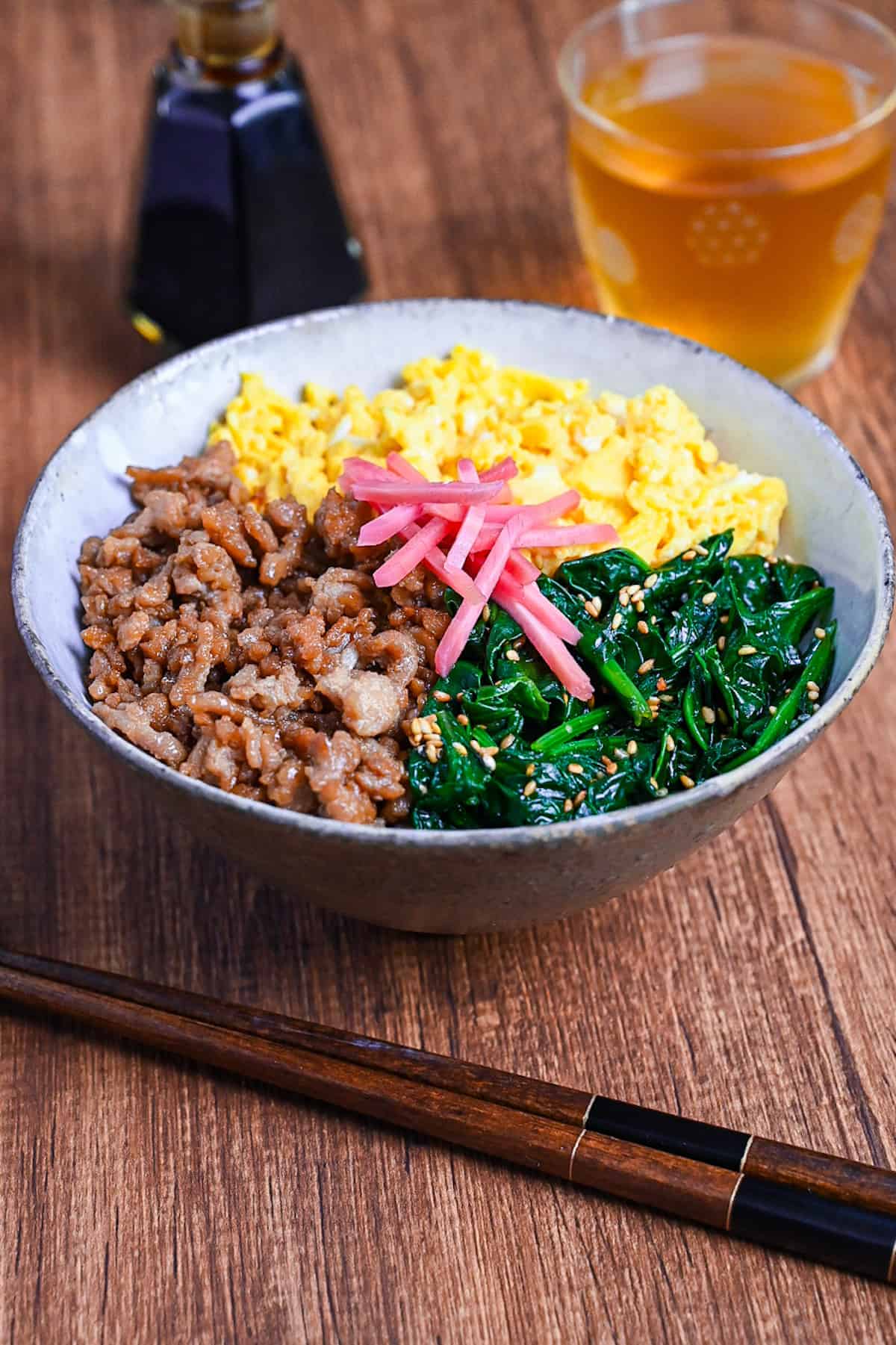
Visual Walkthrough & Tips
Here are my step-by-step instructions for how to make vibrant and delicious Sanshoku Donburi at home. For ingredient quantities and simplified instructions, scroll down for the Printable Recipe Card below.
Heat a frying pan on medium, add a small drizzle of oil and spread it around the pan. Once hot, pour in the egg mixture and allow it to cook until half done. Mix roughly to create chunky scrambled egg.
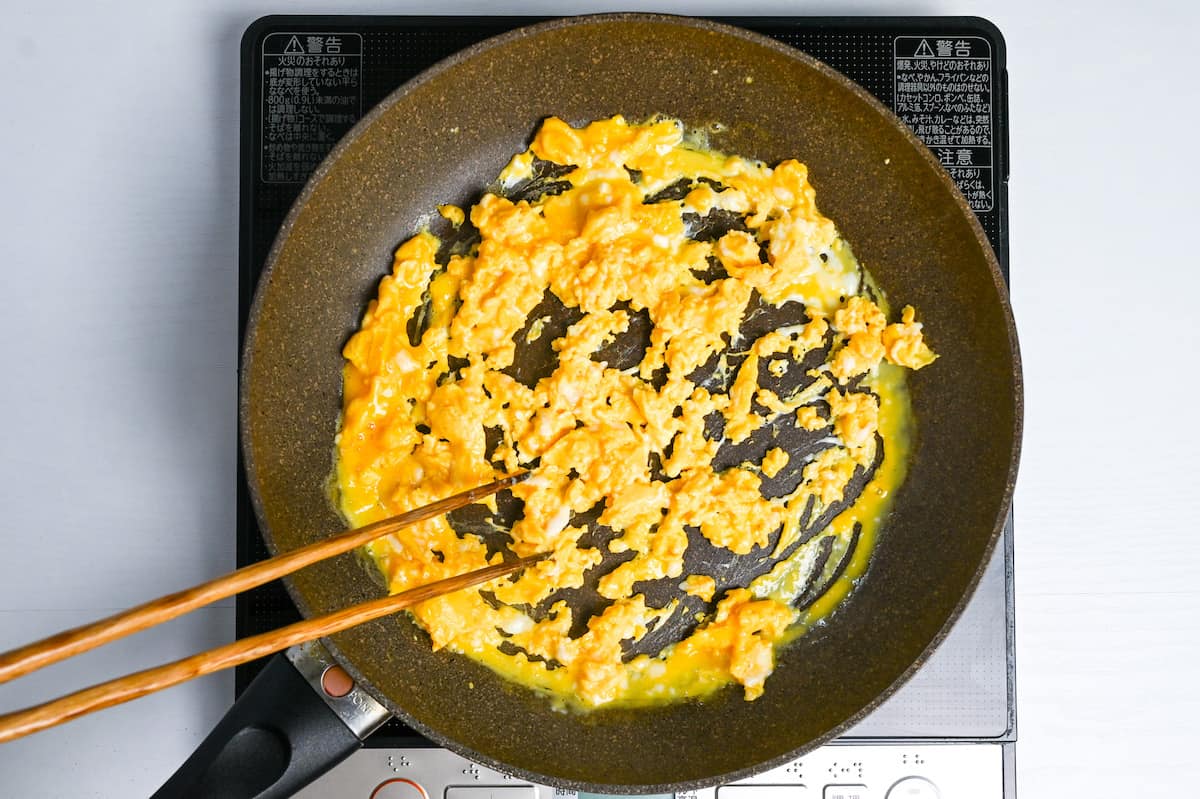
Transfer the scrambled egg to a bowl and set aside. If any egg residue is left in the pan, wipe it out with kitchen paper.
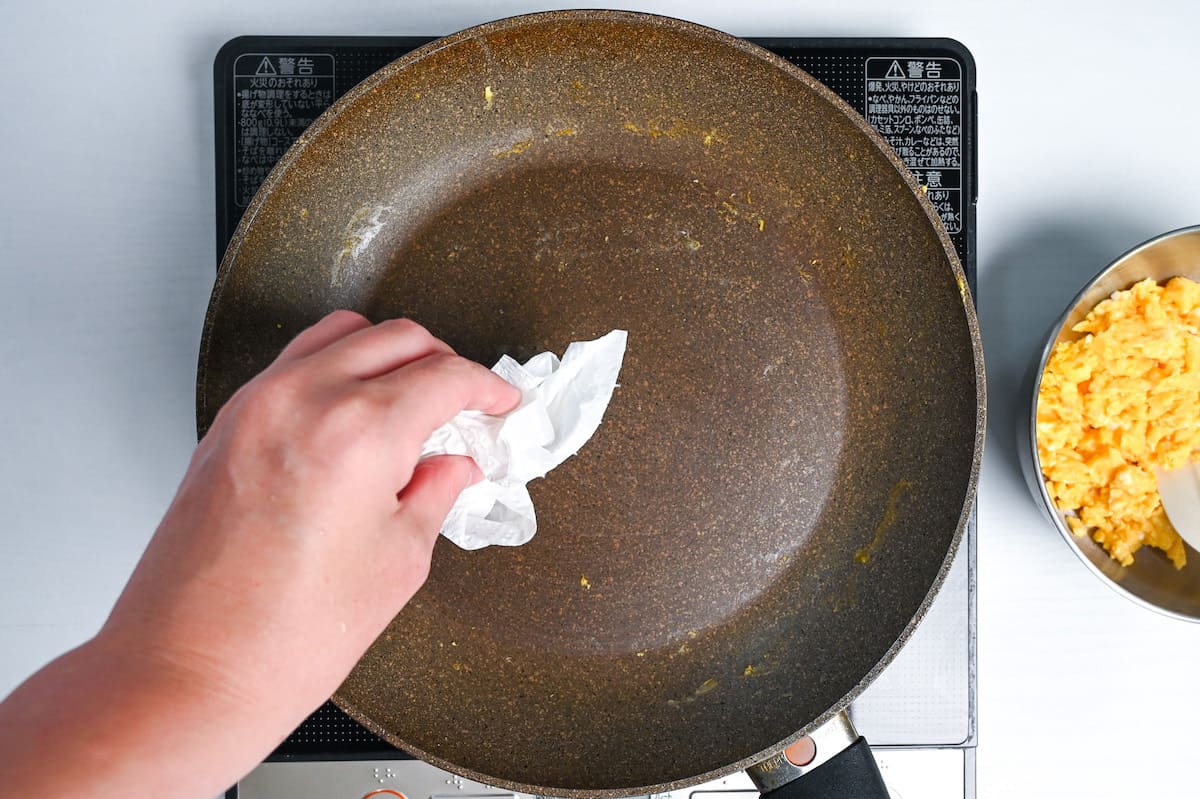
Add a little more oil if necessary and then seal the ground chicken.
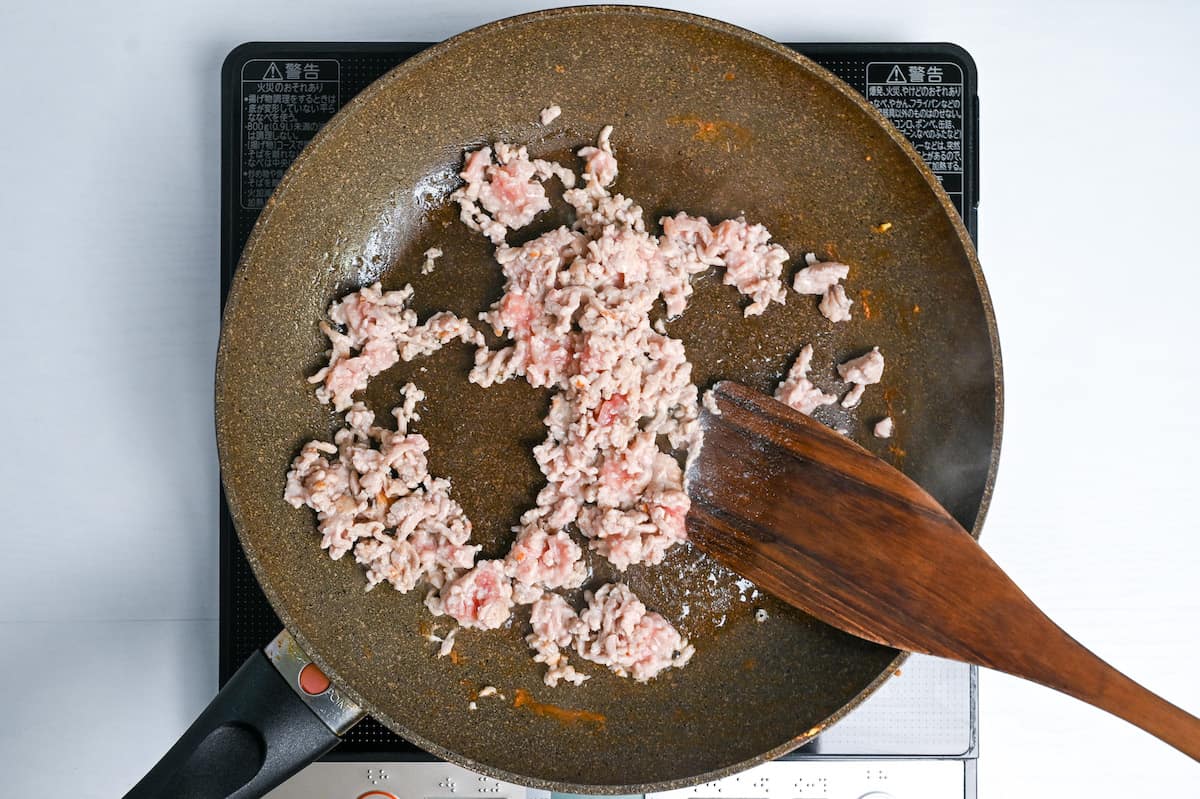
Bring a small pot of water to a rolling boil and add a pinch of salt. Blanch the spinach for about 1 minute.
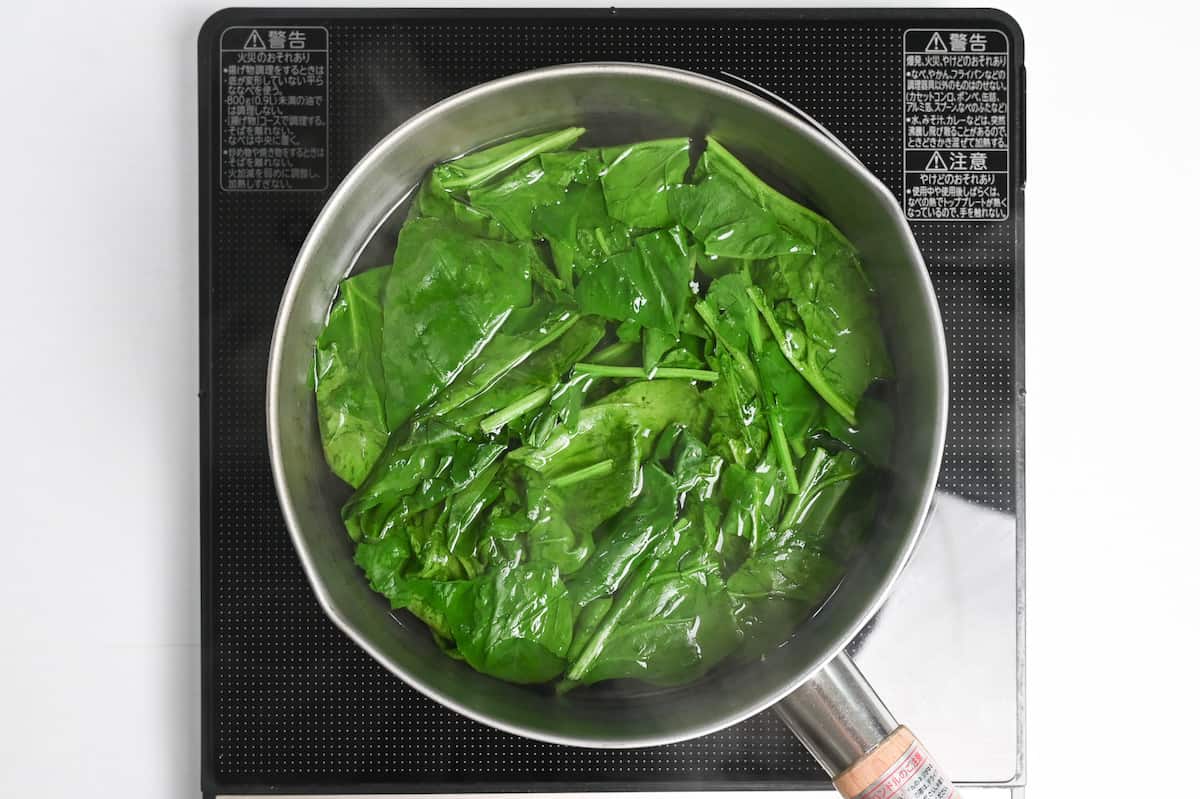
Drain the water and place the blanched spinach in a bowl. Add soy sauce, sugar, toasted sesame oil and sesame seeds and mix well.
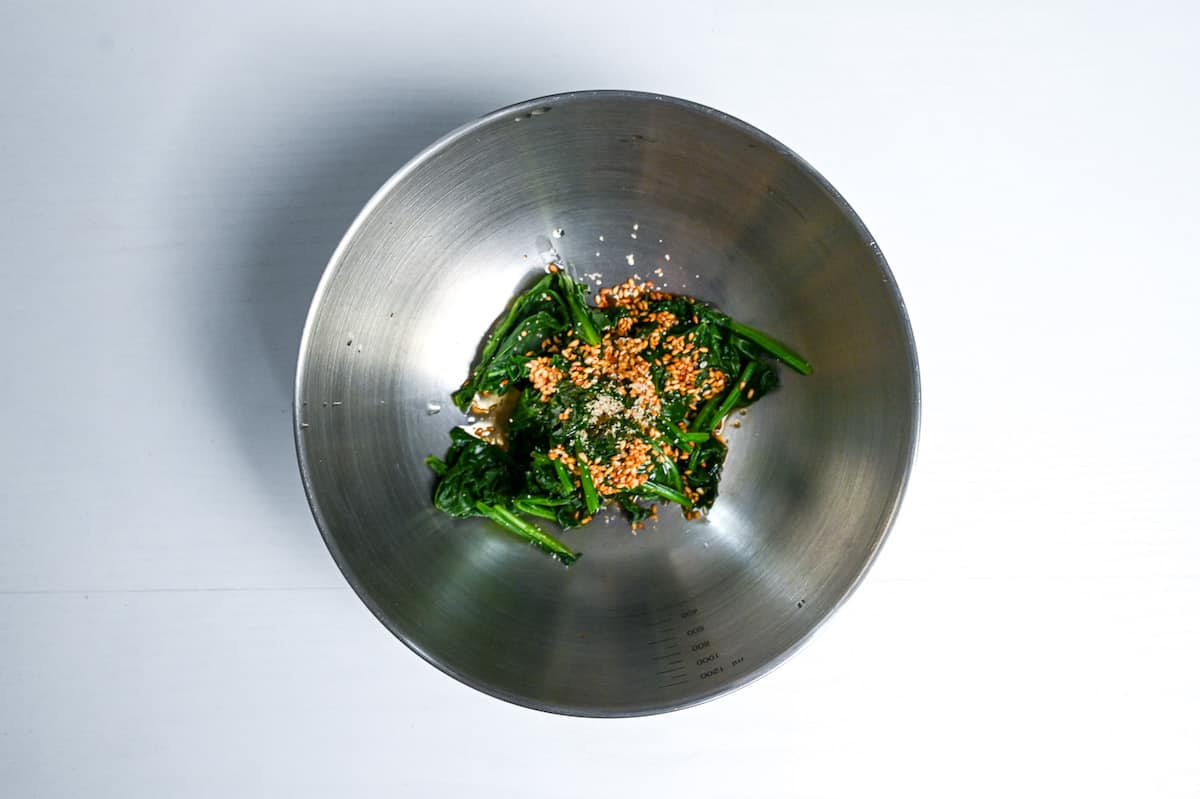
Divide cooked rice into serving bowls.
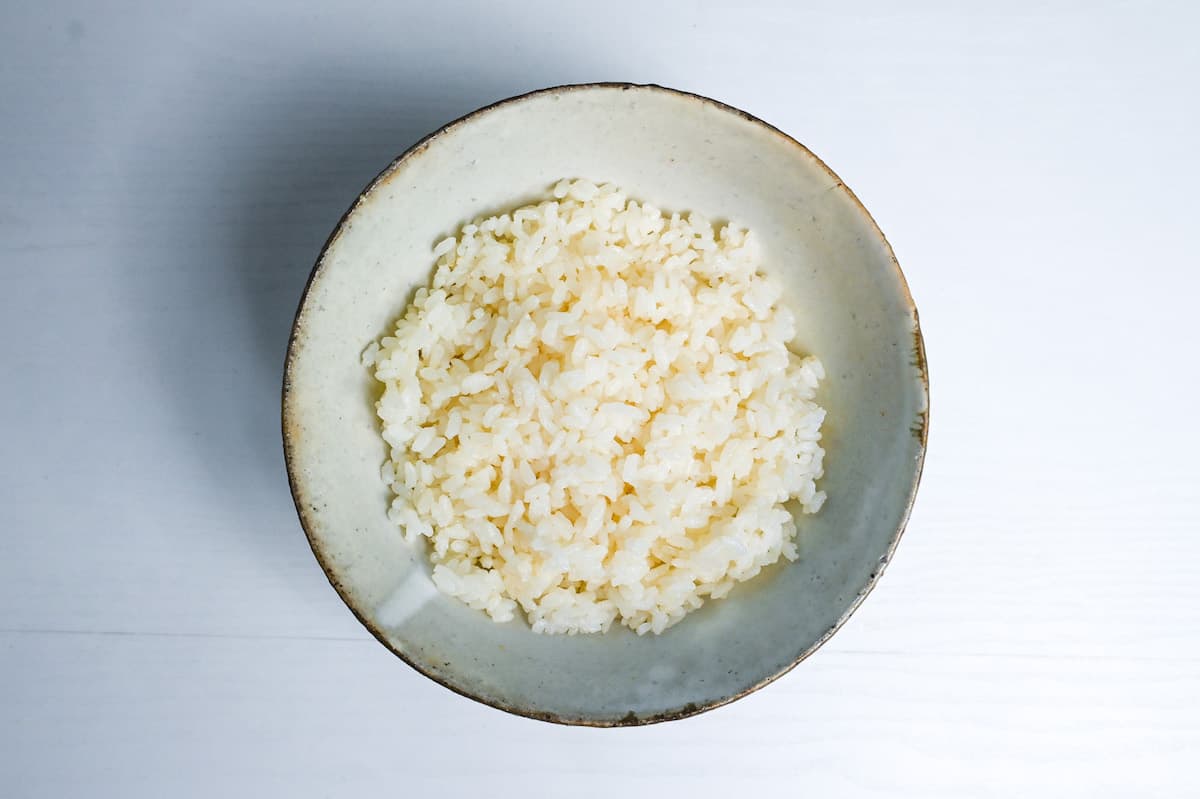
Short-grain Japanese-style rice is the best kind for donburi. Here are the recommended rice brands if you’re interested.
Arrange the scrambled egg, chicken soboro and blanched spinach on top.
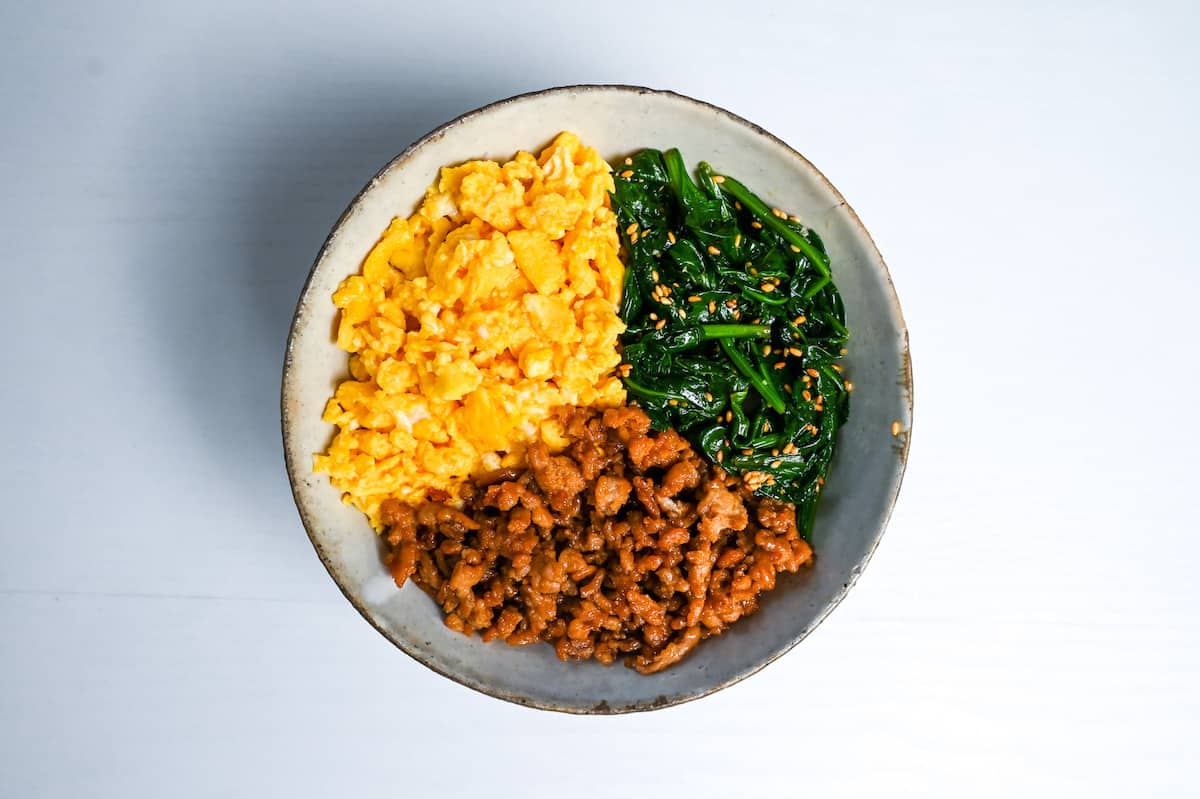
Garnish with red pickled ginger.
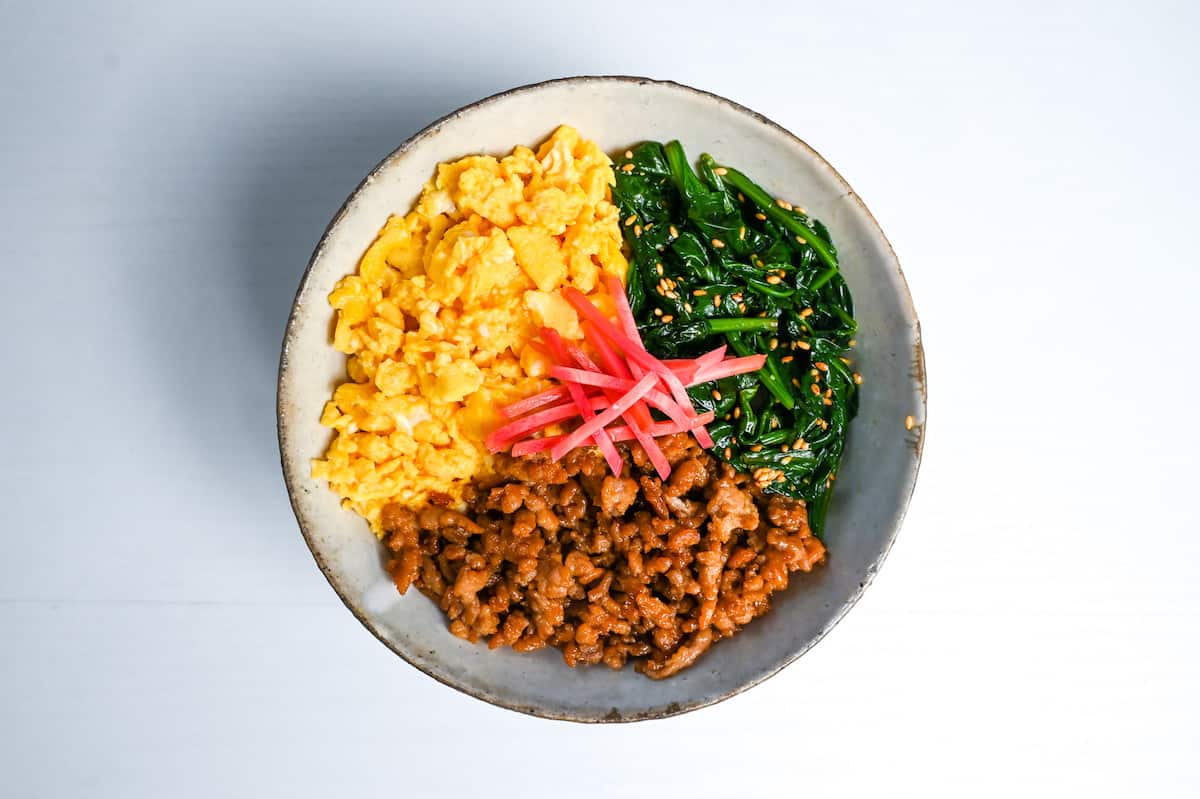
And enjoy!
Jump to Full Recipe MeasurementsFAQ
When a recipe calls for “sake,” it can be confusing to choose the right type, as some specify regular or cooking sake. On Sudachi, “sake” refers to pure sake without added salt (in short, not cooking sake), so if you use cooking sake with salt, adjust the recipe’s salt content accordingly. All dishes on Sudachi are created using drinking sake.
If you want to know more about sake in Japanese cooking, please refer to Sake 101 post written by a professional chef with 30+ years of experience in the industry for the right selection and substitutes.
Soboro Don features a balanced mix of sweet and salty flavors with a prominent chicken taste, which may surprise some with its sweetness. However, the dish’s complexity is best appreciated when its three key components—typically colored for visual appeal—are combined and eaten with white rice. The dish is traditionally served as a bowl of rice topped with these flavorful elements, and the white rice acts as a perfect base, allowing the intricate flavors of the Soboro-don to stand out. Enjoying it this way ensures a harmonious blend of tastes in every bite.
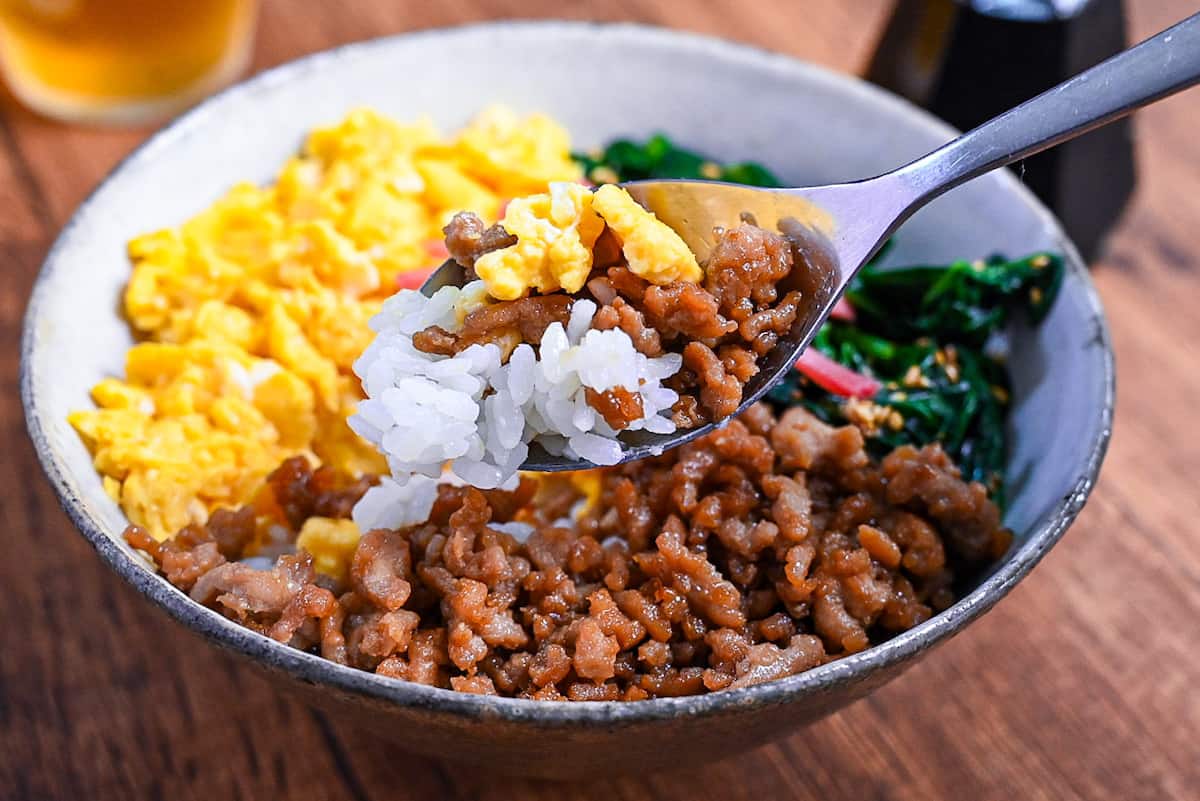
I hope you enjoy this Soboro Don recipe! If you try it out, I’d really appreciate it if you could spare a moment to let me know what you thought by giving a review and star rating in the comments below. It’s also helpful to share any adjustments you made to the recipe with our other readers. Thank you!
More Chicken Donburi Recipes
- Oyakodon (Chicken and Egg Rice Bowl)
- Garlic Teriyaki Chicken bowl (Teriyaki chicken Donburi)
- “Karaage Don” Japanese Fried Chicken Donburi
- Yakitori Donburi (Japanese Chicken Rice Bowl)
Want more inspiration? Explore my Chicken Roundup Post for a carefully selected collection of tasty recipe ideas to spark your next meal!
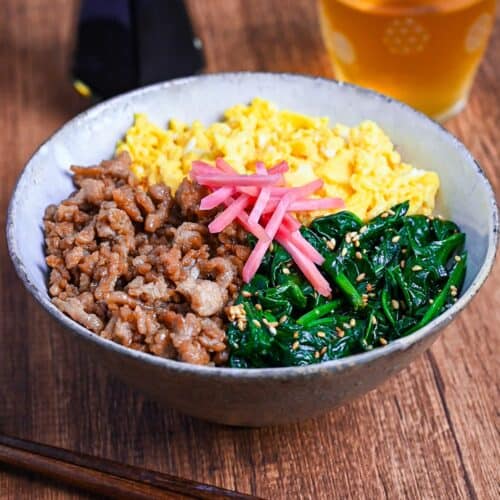
Sanshoku Soboro Donburi (Tricolor Chicken Rice Bowl)
Ingredients
Scrambled Egg
- 3 egg
- ½ tbsp sugar
- 1 tbsp sake
- 1 pinch salt
Chicken Soboro
- 150 g ground chicken
- 1 tbsp Japanese soy sauce (koikuchi shoyu)
- 1 tbsp oyster sauce
- 1 tbsp sake see note
- 1 tbsp mirin
- 1 tbsp sugar
For the Greens
- 60 g Oriental spinach
- 1 pinch salt
- 1 tsp Japanese soy sauce (koikuchi shoyu)
- 1 pinch sugar
- 1 tsp toasted sesame oil
- ½ tsp toasted white sesame seeds
Assembly
- 2 portions cooked Japanese short-grain rice
- 1 tsp red pickled ginger (benishoga) optional
My recommended brands of ingredients and seasonings can be found in my Japanese pantry guide.
Can’t find certain Japanese ingredients? See my substitution guide here.
Instructions
- Crack 3 egg into a mixing bowl and add ½ tbsp sugar, 1 tbsp sake and 1 pinch salt. Whisk them together until well combined.

- Take a non-stick pan and heat it on medium. Add a small drizzle of cooking oil and pour in the egg. Allow it to firm up a little before mixing to make it scrambled.

- Transfer the scrambled egg to a bowl and set aside for later. Wipe out the pan to remove any egg residue.

- Return the pan to the heat and add 150 g ground chicken. (Add a little more oil if necessary.) Cook until lightly browned.

- Add 1 tbsp Japanese soy sauce (koikuchi shoyu), 1 tbsp oyster sauce, 1 tbsp sake, 1 tbsp mirin and 1 tbsp sugar to the mince and cook on a high heat until the liquid is completely reduced.

- Once all the liquid is gone, remove the pan from the heat.

- Bring a small pot of water to a rolling boil and add 1 pinch salt. Add 60 g Oriental spinach and blanch for 1 minute. Once done,

- Drain the water and place the blanched spinach in a small bowl. Add 1 tsp Japanese soy sauce (koikuchi shoyu), 1 pinch sugar, 1 tsp toasted sesame oil and ½ tsp toasted white sesame seeds, and mix thoroughly.

- Dish up 2 portions cooked Japanese short-grain rice into separate serving bowls.

- Arrange the egg, soboro chicken and greens on top.

- Garnish with 1 tsp red pickled ginger (benishoga) (optional) on each portion and enjoy!

Video
Notes
- If you can’t find sake then you can substitute with dry sherry or white wine. The alcohol in the sake will be cooked away but if you really don’t want to use it, you can just add an equal amount of water instead.
- Using a rice cooker is the easiest way to cook rice for donburi but if you want to cook Japanese style rice on the stove, check out my recipe here.
- Adjust the sugar quantity in the recipe to taste – the original version is quite sweet.
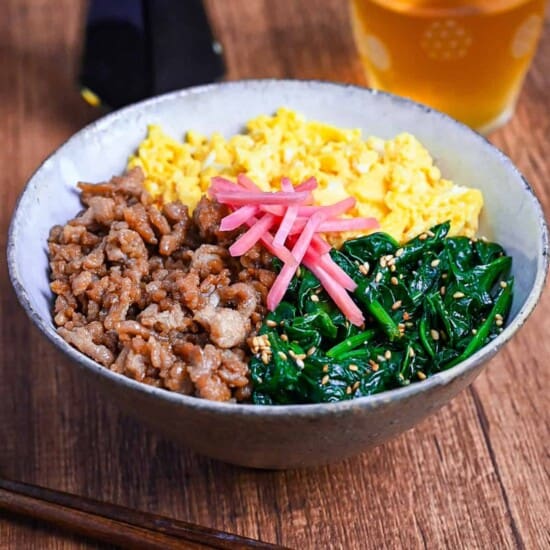



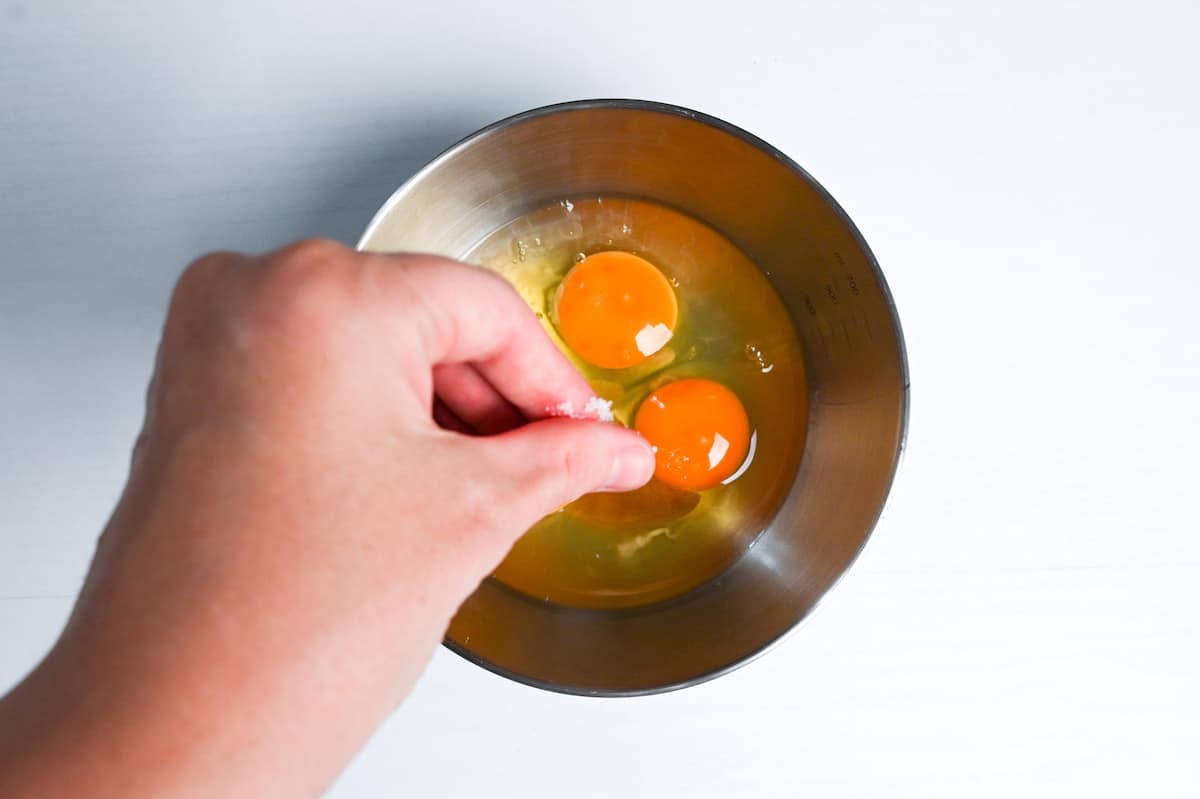

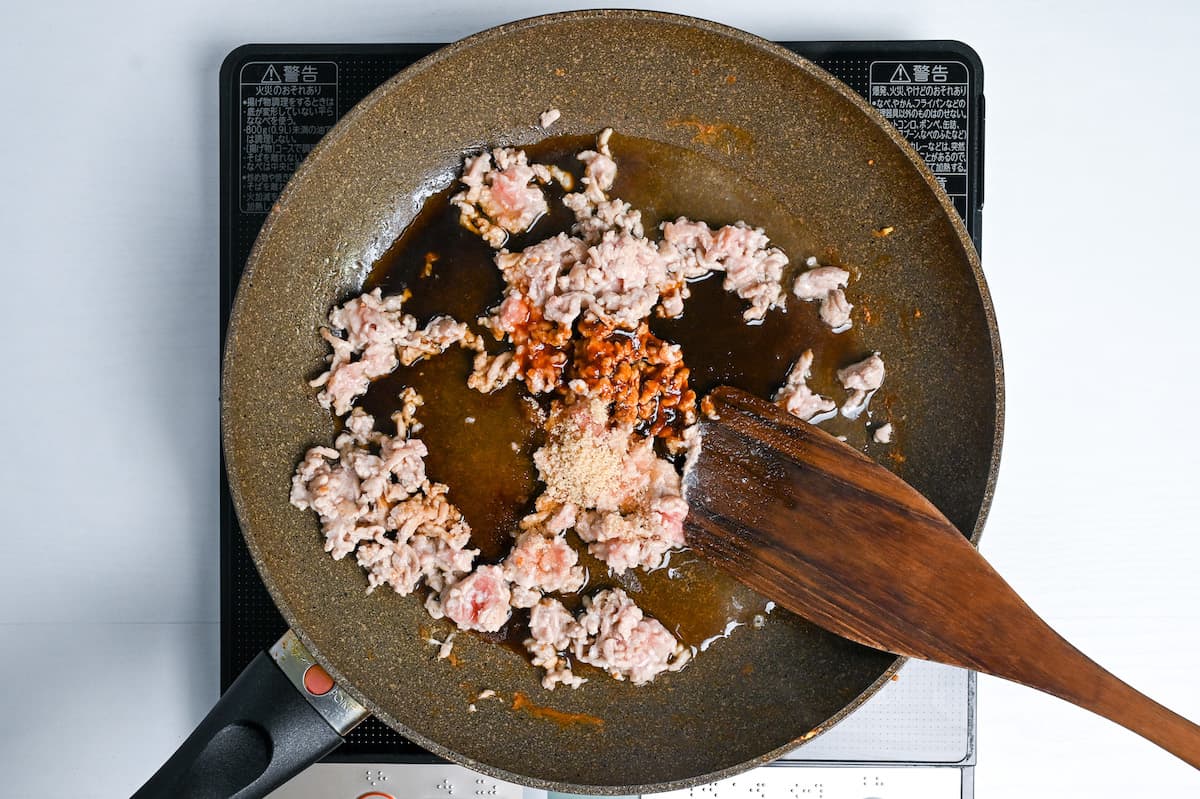
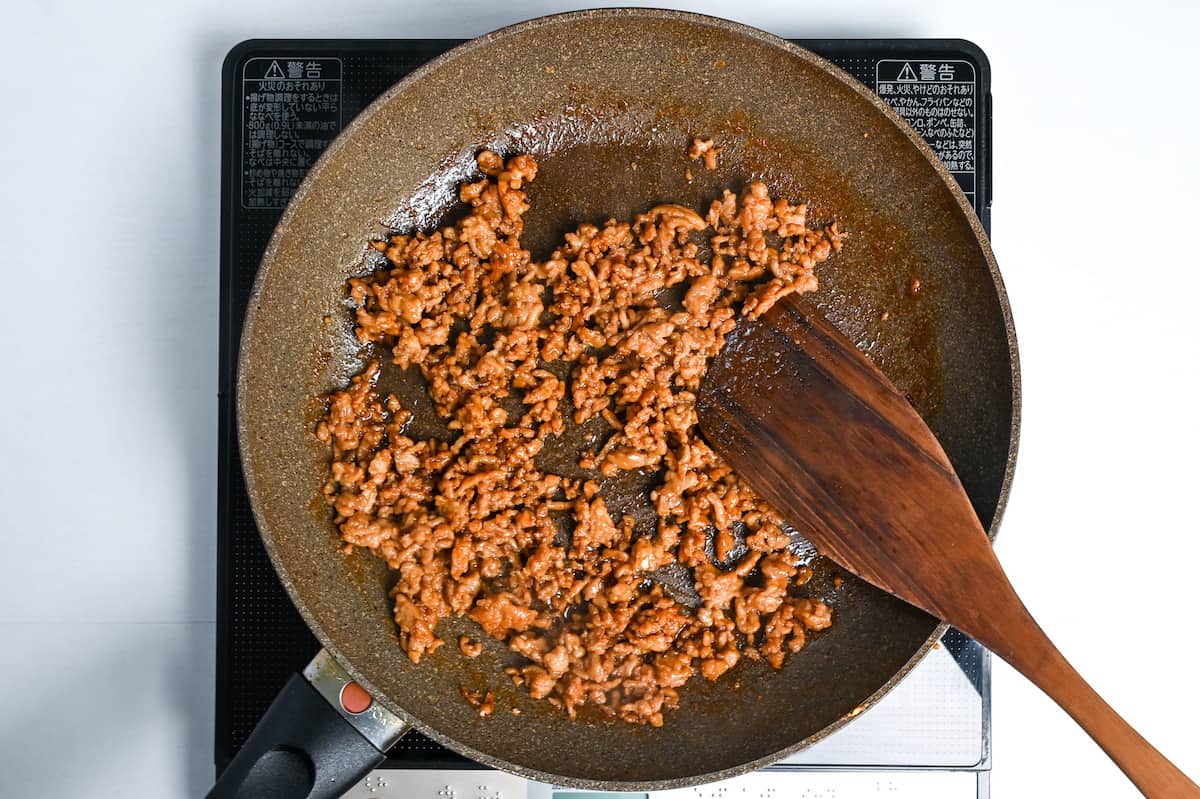

Leave a rating and a comment